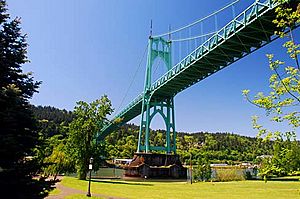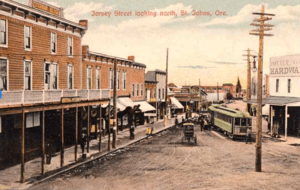St. Johns, Portland, Oregon facts for kids
Quick facts for kids
St. Johns
|
|
|---|---|
|
Neighborhood
|
|
 |
|
| Country | United States |
| State | Oregon |
| City | Portland |
| Area | |
| • Total | 11.02 sq mi (28.55 km2) |
| Population
(2000)
|
|
| • Total | 11,346 |
| • Density | 1,029.28/sq mi (397.41/km2) |
| Housing | |
| • No. of households | 4148 |
| • Occupancy rate | 93% occupied |
| • Owner-occupied | 2333 households (56%) |
| • Renting | 1815 households (44%) |
| • Avg. household size | 2.74 persons |
St. Johns is a cool neighborhood in Portland, Oregon, located in North Portland. It sits right where the Willamette River meets the Columbia River. You can see the famous St. Johns Bridge crossing the Willamette River, leading into the heart of St. Johns.
St. Johns used to be its own city from 1902 to 1915. Then, people in both St. Johns and Portland voted to make it part of Portland. This change happened on July 8, 1915. The neighborhood is surrounded by the Columbia River, the Willamette River, and some streets that separate it from Cathedral Park.
Contents
A Look Back at St. Johns' History
Historian Eva Emery Dye found out that William Clark (from the famous Lewis and Clark Expedition) once camped near what is now Cathedral Park. He stayed there for a night near a Native American village.
How St. Johns Got Its Name
St. Johns is named after an early settler named James John. He traveled to the Pacific Northwest from Westport, Missouri in 1841. He first lived in Linnton, Oregon, before moving across the river around 1844.
About five years after James John settled, nearly 12 other families also claimed land nearby. In 1865, James John had part of his land measured and divided into eight blocks to create a townsite. More blocks were added in 1870 and 1876. James John often gave small pieces of his land to friends who needed help.
After he passed away, James John left his remaining belongings to the town of St. Johns. He wanted the money from selling his property to be used to build a public school. He hoped that children of all religions could learn together and understand the importance of being good citizens.
Early Industries and Growth
In the late 1860s, B. O. Severance built the first major business in St. Johns: a saw mill. After some changes, this building became a factory that made barrels for the sugar trade. When sugar started being shipped in bags, the barrel company closed. The building was then sold again and became the Central Lumber Company.
In 1903, the first electric sawmill in the United States was built in St. Johns by M. B. Rankin. Even though the saw itself worked well, the company didn't keep producing lumber.

In 1902, the Oregon Railroad and Navigation Company built a new train line along the harbor. After this railway was finished, many businesses came to St. Johns, like the Portland Manufacturing Plant.
St. Johns officially became a municipality (its own town with its own government) on January 5, 1902. The early citizens created a new school district and asked the county for approval. In 1904, the St. Johns Civic Improvement League was started. This group helped the new town grow and organize. For example, for almost two years, streets didn't have names and houses didn't have numbers, making mail delivery impossible!
Connecting to Portland
In 1902, people wanted an electric streetcar line to connect St. Johns to Albina and Portland. Before this, people had to switch from an electric car to a steam streetcar to travel to the peninsula. Work to electrify the line began in June 1902.
The St. Johns Shipbuilding Plant was also started in 1904. The St. Johns Library opened in 1907 after the community showed a lot of interest in having a reading room. When it was finished, the Portland Library donated 200 books to the new library.
Community and Change
St. Johns has always been known as a working-class neighborhood. It's famous for its diverse residents and how it's slowly changing. In 2019, about 63% of the people in St. Johns's zip code (which includes other neighborhoods) were non-Hispanic white. This is compared to about 71% for Portland as a whole. St. Johns is a community with people from many backgrounds, including White, Black, Hispanic, Asian, Native American, and Pacific Islander residents. This makes it one of Portland's most diverse neighborhoods.
About 23.5% of people in the 97203 zip code (which covers St. Johns and other North Portland areas) live at or below the poverty line. This means it's one of the city's poorer neighborhoods.
In the 2010s, Portland saw a lot of new buildings and growth. St. Johns is one of the fastest-growing parts of Portland. Because of the rising cost of living, many long-time residents of North Portland are finding it hard to stay in their homes.
Getting Around St. Johns
In May 1901, the Oregon Railroad and Navigation Company (O. R. & N.) started planning a new train project for St. Johns. At that time, St. Johns was a small settlement with farms and few roads. The new rail line was built to help transport goods for the growing businesses around St. Johns. The 5.5 miles of track were placed near Swan Island and curved around Portland University. The construction was finished in 1902.
An extension to the City & Suburban Rail Company's line was announced. This would connect North Albina to St. Johns. The company built double tracks for steam trains. Passengers would get off at Ockley Green Station and then take electric cars to Albina and eventually Portland.
In July 1903, the St. Johns Railroad Company announced they would build an electric streetcar line from St. Johns to North Albina. A year before, Portland's City & Suburban Rail Company had already made their passenger lines to St. Johns electric. Before that, St. Johns was a bit cut off from Portland. Steam passenger cars were available, but the route was long and not very efficient. After the streetcar was installed, travel time to the town became much shorter. This helped the population and the number of businesses grow steadily over the next few years.
Francis I. McKenna, who led the company building the electric line, was an important person in University Park. He made his money in real estate but also helped with anything he felt would improve his community.
Even with the new lines, people still had to transfer at Piedmont Junction in Albina to get directly to Portland. In February 1905, the St. Johns Commercial Association asked the Portland Consolidated Railway Company for a direct line to Portland without transfers. They also wanted the streetcars to run every twenty minutes. Just weeks later, the streetcar manager announced a new direct service to Portland without transfers. However, the company kept their old thirty-minute schedule. This change was very important because the Lewis and Clark Centennial Exposition was expected to bring many visitors to the town.
In 1911, under Mayor Kindel C. Couch, the town of St. Johns spent a lot of money on improving its roads, sidewalks, and sewers. To pay for this, the city encouraged businesses to hire more workers. This meant more people would pay taxes, buy homes, and spend money in local shops. This plan worked! The Portland Woolen Mills, located near the waterfront, doubled its monthly payroll and employed 300 workers. The St. Johns Lumber company also had a large payroll, with workers often doing overtime to keep up with demand.
Schools in St. Johns
Public schools in St. Johns are part of the Portland Public Schools system. They include Roosevelt High School, George Middle School, Sitton Elementary School, and James John Elementary School. The neighborhood is also served by Faubion School and Jefferson High School. A small part of the northern tip of the neighborhood is in the Scappoose School District.
What St. Johns Makes and Does
The main business area of St. Johns has many unique shops and local restaurants. You can even find two theater pubs there! The northern part of the neighborhood is home to a large industrial area. This area has many warehouses, parking lots, and places for cargo and shipping. This includes the 11 square kilometer Rivergate Industrial District of the Port of Portland.
Nature in St. Johns
St. Johns and North Portland are known for being close to beautiful natural areas. There are many parks and natural spots in St. Johns, such as Pier Park, the Columbia Slough, Kelley Point Park (opened in 1984), Pier Park (opened in 1959), and the Smith and Bybee Wetlands Natural Area (opened in 1961). It's also near Cathedral Park and Baltimore Woods, and right across the river from Forest Park. When you enter St. Johns, you'll see a sign that says, "Welcome to the Peninsula, Gateway to Nature." It's common to see amazing birds like bald eagles and other birds of prey here!
Images for kids







